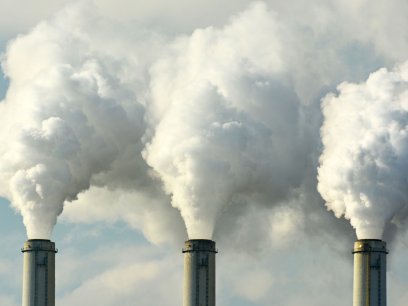
A large body of fully vetted scientific research provides compelling evidence that solar output from our Sun is not a major factor in causing the global atmospheric temperature increases observed over the past six-plus decades.
It's not surprising that people think first of the most obvious part of our solar system, the Sun, when thinking about factors that warm Earth's atmosphere. The Sun is, after all, the provider of virtually all the energy in Earth's climate.
Not surprising, but also not correct. Not correct, that is, when it comes to understanding the observed global temperature increases over roughly the past six decades. Over the past four decades, total solar irradiance has shown no particular trend. Given the Sun's slight cooling trend and the overall warming atmosphere, the Sun and the planet's climate actually have been moving in opposite directions.
It's a case where the scientific evidence refutes the easy or “knee-jerk” first-impulse, and in that respect it's not so unusual.
Long-term solar output from the Sun, after all, strongly influences Earth's temperature and climate, but it cannot explain the increased warming during the Industrial Age. The National Research Council has reported that indirect estimates of solar output measured by sun spot activity in fact showed a slight increase during the first few decades of the 20th century, and those increases indeed may have contributed to warming during that period. But with satellite measurements available since 1979 having replaced less-precise sun spot observations, it is clear that solar output cannot be the major contributor to higher temperatures since the 1950s.
An extensive body of scientific research and evidence counters claims published in 1991 suggesting “strikingly good agreement” between solar cycle lengths and land surface temperatures between 1860 and 1990. That lone scientific study has given rise to much of the mistaken “It's the Sun” premise. Using various statistical and physical approaches, scientific researchers have shown relatively small solar contributions to global warming over the past half-century-plus, and supporting data from satellites and weather balloons have withstood vigorous scientific scrutiny in rejecting the notion that the Sun's output is responsible for warming during the latter part of the 20th century.
On the contrary, solar output calculations based on satellite data and sun spot activity and a range of independent measures of solar activity actually show a “slight cooling influence” in recent decades. Researchers Grant Foster and Stefan Rahmstorf, for instance, reported in 2011 that between 1979 and 2010 solar activity had a cooling effect of between -0.014 and -0.023°C. Researchers Judith Lean and David Rind earlier had found that solar activity can account for about 11 percent of global warming between 1889 and 2006, but only for about 1.6 percent of the warming between 1955 and 2005, with a slight cooling effect â about -0.004 degrees°C â from 1979 to 2005.

A Telltale Sign: Differences in Atmospheric Layers
One telltale sign the scientific community points to in concluding that solar radiation is not a major factor in recent warming involves differences between the troposphere, the lower layer of the atmosphere, and the stratosphere, the upper layer. The physics of increased solar output holds that there would be a uniform warming at all layers of the atmosphere as a result of increased solar radiation. But just the opposite has occurred: warming at the lower level and cooling at the upper layer.
“This is exactly the vertical pattern of temperature changes expected from increased greenhouse gases, which traps energy closer to the Earth's surface,” according to the National Research Council, part of the National Academy of Sciences. “If an increase in solar output were responsible for the recent warming trend, the vertical pattern of warming would be more uniform through the layers of the atmosphere.”
But without that uniform pattern of vertical warming of the atmosphere, the physics makes clear that it's not a question of solar radiation, but rather of greenhouse gases.
References and Resources
- Climate Change 2013: The Physical Science Basis: Summary for Policymakers, Working Group I Contribution to the Fourth Assessment Report of the Intergovernmental Panel on Climate Change, 2013, World Meteorological Organization and United Nations Environment Programme.
- The Discovery of Global Warming, Spencer R. Weart, 2008, Harvard University Press.
- The Rough Guide to Climate Change: The Symptoms, The Science, The Solutions, 2011, Robert Henson, Roughguides.com.
- The Thinking Person's Guide to Climate Change, 2014, Robert Henson, AMS Books.
- Skeptical Science.com
- Climate Stabilization Targets: Emissions, Concentrations, and Impacts over Decades to Millennia: Report in Brief, 2010, National Academy of Sciences.
- Understanding and Responding to Climate Change: Highlights of National Academies Reports,2008, The National Academies.
- Climate Change 101: Understanding and Responding to Global Climate Change, undated, Pew Center on Global Climate Change/Center for Climate and Energy Solutions.
- Science, Evolution, and Creationism, National Academy of Sciences/Institute of Medicine, 2008, The National Academies.
About the Author
Morris A. (Bud) Ward, editor of Yale Climate Connections, is a proven and widely experienced communicator and educator on environmental, energy and climate change issues. He has an extensive publishing history including hundreds of bylined news and analysis articles and authorship or co-authorship of five professional books. He has conducted numerous first-hand workshops for reporters, editors and policy makers on issues involving journalism/communications, climate change and environmental risk. He writes, speaks and teaches regularly on issues related to climate change and on the changing nature of journalism and mass communications in modern society.


